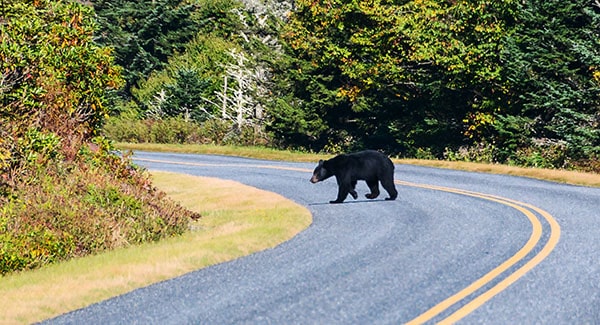
Last Updated on November 7, 2023
Western North Carolina’s broad range of elevations, climates, and plant growth makes this one of the most biodiverse regions in the world! But encountering animals in their natural habitat can sometimes be dangerous for both you and them if you do not practice the proper trail safety tips.
Allen Tate/Beverly-Hanks is an Official Sponsor of NC Year of the Trail, a year-long initiative promoting trails throughout our state. And part of enjoying the trail means being aware of your surroundings and the wildlife you come across.
Stay alert! Stay safe on the trail—and keep wildlife safe—by practicing these 12 trail safety tips.
6 Tips to keep yourself safe while enjoying local trails
Wear the right clothes
First and foremost, having the right footwear for your outdoor adventure is what will make or break your experience. Choose hiking boots or trail runners that fit properly and can grip the trail. Wear the right socks to prevent blisters. Dress in layers, and choose moisture-wicking and quick-drying clothing when you can. And be prepared for the weather and elevation. It never hurts to pack an extra jacket for a chilly mountaintop or a raincoat for a summer storm.
Have an emergency plan
If you’ve never spent a full day (or longer) on the trails before, it’s important to understand the essentials to pack to have a positive experience. Extra food and water, sun and bug protection, and maps or navigation aids are important to have on hand. You also want access to a first aid kit and a communication device (like your cell phone) with a battery backup. Most importantly, never explore new trails or lightly trafficked trails alone. Bring a friend! Or if you are choosing to hike an easily accessible and well marked trail alone, tell at least two people where you plan to be.
Understand local regulations and trail etiquette
Many WNC trails are open to anyone, but you should always confirm whether you need a reservation, permit, or park pass. If you plan to camp, make sure camping is allowed, and check to see whether campfires are permitted.
On the trails, it’s common to come across hikers, mountain bikers, equestrians, and even hunters (see below). Understand the rules of basic hiking etiquette, and follow all trail regulations, especially those pertaining to pets. Basic etiquette rules dictate that when two hikers pass each other, uphill hikers have the right of way. Mountain bikers should yield to hikers whenever they can. And hikers should always yield to horses.
Beware of waterfalls
It’s no secret that our region is full of scenic waterfalls, big and small. In fact, Transylvania County is known as “The Land of Waterfalls” for the 250+ flowing within their borders alone! But a great experience can turn deadly if you aren’t vigilant. Beware of dangers surrounding waterfalls by being aware of waterfall safety tips. These include following all instructions posted at waterfalls and along trails. Watch your footing at all times—dry rocks can sometimes be as slippery as wet rocks. And be prepared for emergencies by carrying dry clothes and a charged cell phone.
Keep up with hunting season
It’s always possible to encounter wild animals while on the trail. But it’s also possible to encounter people tracking those animals. Take note of the dates of this year’s hunting season, and avoid the trails during “high use” hunting times, typically the opening days of the season or special hunting dates. Understand where hunting is allowed, and try to find trails that don’t overlap with popular hunting grounds. And don’t forget: hunting in North Carolina is restricted on Sundays, which makes that a better day to hike.
Make yourself seen and heard
It’s wise to avoid hiking at dawn or dusk, when animals are active and hunters have trouble seeing. No matter the time of day, make sure you can be seen by your fellow man. Wear blaze orange vests or caps for safety on the trail. If you hike with your dog, keep it on the leash at all times, and consider dressing it in a safety vest, as well. Making noise is also a great way to scare off critters while also making yourself known to other trail-goers like hunters.
6 Safety tips to protect wildlife near you while on the trail
Leave no trace
Among the essentials you pack for your hike should be a garbage bag. Do not litter. Do not leave trash or food scraps. Understand how to properly store your food, especially if you’re camping overnight. Pick up after your dog, and carry the waste with you. (Circling back to pick up your doggy doo bag on the way back is considered bad form.) Be considerate of other visitors, especially the wildlife that travels through those forests. Deposit all trash properly into bins at the beginning or end of the trail.
Stay on marked trails
Respect wildlife. And do not break through undergrowth. It can be tempting to create your own makeshift trail to get a better view of a valley or take a shortcut to a waterfall. But you put your own safety at risk when going off trail. And it makes it more likely that you will damage fragile ecosystems, including wildflowers and small animals. Creatures like the Eastern Hellbender are protected species, in large part because of habitat destruction and loss. Staying on the trail helps ensure that off-trail habitats remain safe and healthy for wildlife.
Only take photos and memories
It’s tempting to take natural souvenirs home from your outdoor adventures: rocks and pebbles, wildflowers, pine cones or acorns, etc. But as we mentioned above, everything you see around you is the home of local wildlife, even if you can’t see them. Digging up plants or taking stones can disrupt habitats immediately. On longer timelines, taking seeds or other items can impact the ecosystem’s natural ability to grow and regenerate. It’s better to leave everything just as you found it.
Research local animals
Our mountains and rivers are full of fascinating creatures, great and small. The best way to know what kinds of wildlife you may encounter along a trail is to know what lives there. In Western North Carolina, that can mean bears, coyotes, bobcats, foxes, deer, elk, wolves, rattlesnakes, birds of prey, and much more. Some, like the distinctive Eastern spiny softshell turtle, can only be found in the French Broad River basin. You may not encounter dangerous animals along your hike, but if you do, here are some tips.
Get up close and personal—at a wildlife education center
Wildlife experts do not recommend pursuing up-close animal encounters in the wild. We’ll say that again: DO NOT APPROACH WILDLIFE. Your safety is always paramount, and the animals’ health and safety are important, too.
Instead, we prefer meeting creatures through one of the many wildlife programs in our region. From the WNC Nature Center in Asheville to the Cradle of Forestry in America Heritage Site in Pisgah Forest and Team ECCO Aquarium & Shark Lab in Hendersonville—there are many great ways to engage with local wildlife throughout our region.
Clean your gear
The last of our trail safety tips for today extends beyond North Carolina and NC Year of the Trail. It’s fun to travel to trails in protected areas like national parks. It’s a great way to see the country, and it’s a wonderful way to experience other climates, elevations, and ecosystems. But the further afield you travel, the more likely you are to transfer contaminants from one ecosystem to another. Clean your gear after every hike to prevent the transfer of seeds, insects, or pathogens from one location to another.
What is NC Year of the Trail?
Allen Tate/Beverly-Hanks is proud to be an Official Sponsor of NC Year of the Trail! This year-long endeavor celebrates our state’s vast network of trails, greenways, and blueways—and is the largest statewide celebration of trails and outdoor recreation in North Carolina history!
North Carolina is the Great Trails State, where each of North Carolina’s 100 counties should be able to enjoy the proven benefits of trails, including health, safety, economic development, tourism, transportation, and environment. Trails are the backbone of our state’s growing $28 billion outdoor recreation economy.
There are many great trails across our Western North Carolina communities. No matter your age, background, or abilities, there is a trail out there for you! We hope you’re inspired by today’s post about trail safety tips for yourself and local wildlife. This year, we’ve covered many topics related to NC Year of the Trail, including:
- Lesser-known hiking and biking trails.
- Accessible town and mountain trails.
- Outdoor outfitters that will prep you for your trail.
- Unexpected types of local trails.
- And Trails that lead to exciting destinations.



